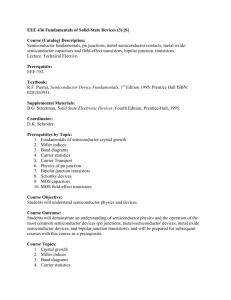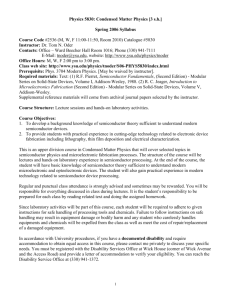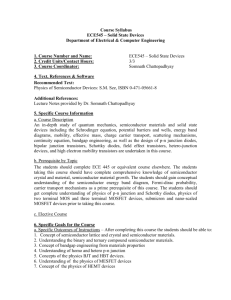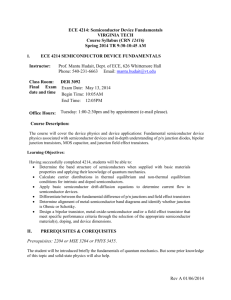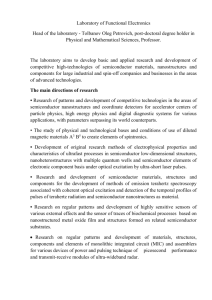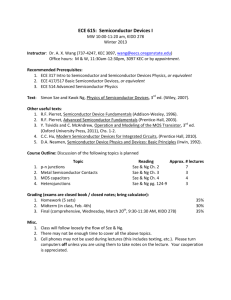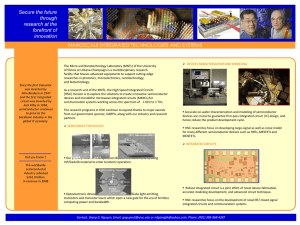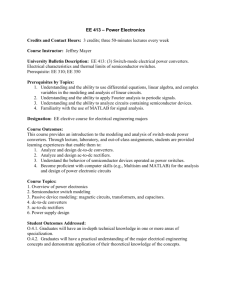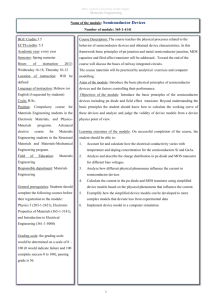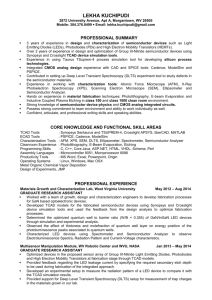Course Memo - University of Virginia
advertisement
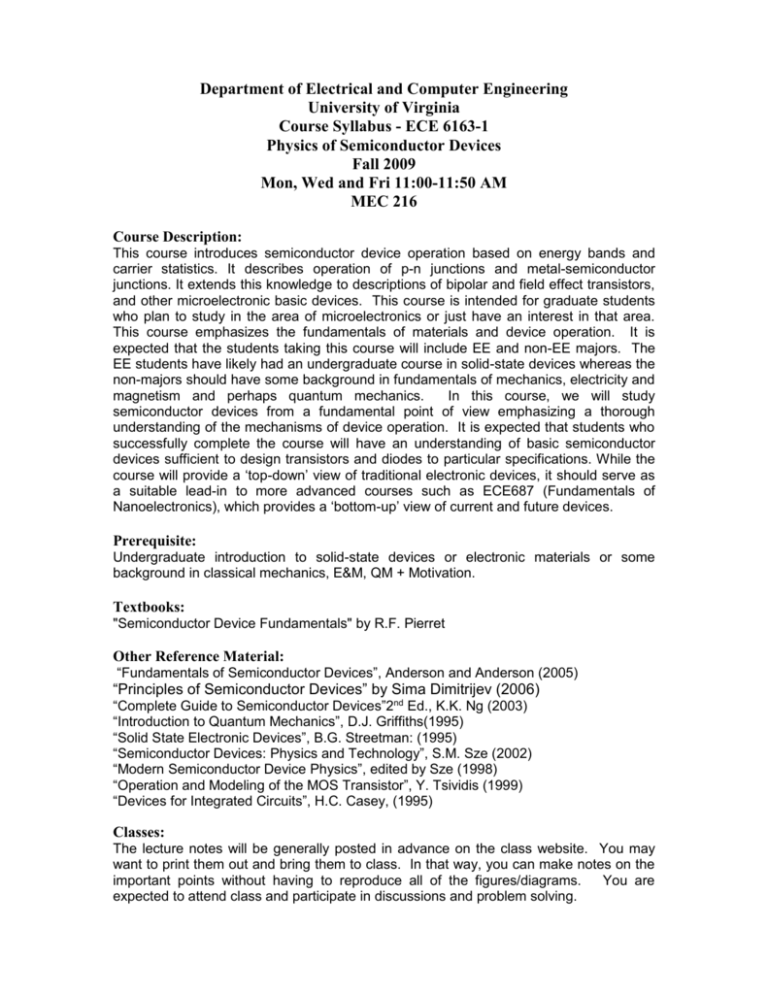
Department of Electrical and Computer Engineering University of Virginia Course Syllabus - ECE 6163-1 Physics of Semiconductor Devices Fall 2009 Mon, Wed and Fri 11:00-11:50 AM MEC 216 Course Description: This course introduces semiconductor device operation based on energy bands and carrier statistics. It describes operation of p-n junctions and metal-semiconductor junctions. It extends this knowledge to descriptions of bipolar and field effect transistors, and other microelectronic basic devices. This course is intended for graduate students who plan to study in the area of microelectronics or just have an interest in that area. This course emphasizes the fundamentals of materials and device operation. It is expected that the students taking this course will include EE and non-EE majors. The EE students have likely had an undergraduate course in solid-state devices whereas the non-majors should have some background in fundamentals of mechanics, electricity and magnetism and perhaps quantum mechanics. In this course, we will study semiconductor devices from a fundamental point of view emphasizing a thorough understanding of the mechanisms of device operation. It is expected that students who successfully complete the course will have an understanding of basic semiconductor devices sufficient to design transistors and diodes to particular specifications. While the course will provide a ‘top-down’ view of traditional electronic devices, it should serve as a suitable lead-in to more advanced courses such as ECE687 (Fundamentals of Nanoelectronics), which provides a ‘bottom-up’ view of current and future devices. Prerequisite: Undergraduate introduction to solid-state devices or electronic materials or some background in classical mechanics, E&M, QM + Motivation. Textbooks: "Semiconductor Device Fundamentals" by R.F. Pierret Other Reference Material: “Fundamentals of Semiconductor Devices”, Anderson and Anderson (2005) “Principles of Semiconductor Devices” by Sima Dimitrijev (2006) “Complete Guide to Semiconductor Devices”2nd Ed., K.K. Ng (2003) “Introduction to Quantum Mechanics”, D.J. Griffiths(1995) “Solid State Electronic Devices”, B.G. Streetman: (1995) “Semiconductor Devices: Physics and Technology”, S.M. Sze (2002) “Modern Semiconductor Device Physics”, edited by Sze (1998) “Operation and Modeling of the MOS Transistor”, Y. Tsividis (1999) “Devices for Integrated Circuits”, H.C. Casey, (1995) Classes: The lecture notes will be generally posted in advance on the class website. You may want to print them out and bring them to class. In that way, you can make notes on the important points without having to reproduce all of the figures/diagrams. You are expected to attend class and participate in discussions and problem solving. Instructor: Prof. Avik Ghosh. My office is in Thornton Hall, Room E315. You are welcome to stop by my office at any time. You may want to e-mail ahead to be sure that I am in my office. I can also answer many questions via e-mail. My address is ag7rq@virginia.edu. WWW: The class web page is http://people.virginia.edu/~ag7rq/663/Fall09/courseweb.html. There you will find the syllabus, homework assignments and solutions, and other materials for the class. Homework: Homework will be assigned nearly every week, and will be due about one week later, in class. Late homework will not be accepted. However, the lowest homework grade will be dropped. Homework assignments and solutions will be posted on the class website. You will be expected to use Mathcad, Matlab, or similar programs to complete some of the homework problems and exam questions. I strongly encourage you to work together in small groups to discuss or solve home problems as teams BUT when you write it down, do so alone (i.e. what I see should come from your head alone). We will have inclass homework solution discussions where you can earn valuable brownie points. You should check the class website for homework assignment postings. Solutions will also be posted on the class website after the assignments are turned in. Grading: There will be three tests given. Each of the tests will be open-book/take-home. Your final grade will be based on your test scores and homework. The approximate weighting will be as follows: Exam 1 ~15%, Exam 2 ~25%, Exam 3 ~35%, Homework ~25%. Class Topics: Crystals and Semiconductor Materials Introduction to Quantum Mechanics (QM101) Application to Semiconductor Crystals – Energy Bands Carriers and Statistics Recombination-Generation Processes Carrier Transport Mechanisms P-N Junctions Non-Ideal Diodes Metal-Semiconductor Contacts – Schottky Diodes Metal-Oxide-Semiconductor Transistor (MOSFET) Photonic Devices MOSFET Operation and Scaling Bipolar Junction Transistors (BJT) Course Objectives: The general goal of this course is to allow the students to understand the fundamentals of semiconductor behavior and the operation of basic semiconductor devices. By the end of the course, the students will be able to design diodes and transistors to a given set of specifications. Additionally, this course lays the foundations for the understanding of a vast array of other more advanced semiconductor devices such as those covered in more advanced courses.
